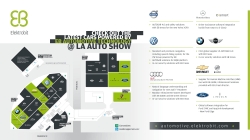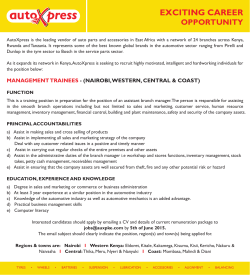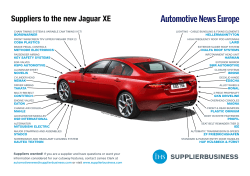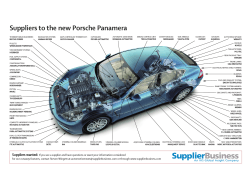
Managing complexity with agile development
EB TechPaper Managing complexity with agile development automotive.elektrobit.com 1 Managing complexity with agile development The widespread use of smartphones in cars as well as the advent of automated driving and progressive networking has led to electronics and software playing an increasingly important role in automotive manufacturing. Faster innovation cycles, greater vehicle diversity and high development costs, plus new statutory requirements and mobility concepts, are driving car makers into alliances with development partners outside the automotive sector. At the same time, the growing significance of software is fundamentally changing the relationship between manufacturers and suppliers as increasing complexity makes traditional make-toorder production practically impossible. It has been replaced by new flexible and transparent processes. But what do these models look like in practice? New software development models Development models such as Lean Development, Agile Development, Scrum and Kanban involve the customer in the development process to a greater extent. Lean development is all about streamlining structures and processes, continuous improvement and giving the development team more autonomy. Agile development focuses on risk minimization to increase development process transparency and shorten time-to-market. This is achieved by using shorter development cycles and increasing the frequency of liaison and feedback processes between the automaker and the supplier. It extends across all hierarchical levels, from developer to management. The result is faster development of implementable systems that can be used as the base for further modifications. Scrum is essentially the implementation of both the previous concepts in software projects. Project task complexity is reduced by structuring them in small and manageable units called sprints. Again the objective is to increase transparency and deliver usable results faster. Kanban reduces the number of parallel work packages through workflow visualization. This makes project progress and project constraints more transparent. All models aim to establish long-term and trusting partnerships based on the intensive involvement of all project stakeholders. Although agile development has been used very successfully for many years in the IT sector, it was only recently introduced in the automotive industry. Some providers are already using the above-described methods to reduce their software’s error susceptibility and achieve ongoing improvements. However, a consistent switch-over that meets all sector requirements will necessitate the combination and adaptation of the various agile models. This is a complex undertaking requiring a great deal of management expertise, a special corporate culture and a high level of mutual trust. It makes sense for the automotive industry to phase in this process over time as Elektrobit and Ford did when they collaborated on the SYNC system. New challenges in software development From Martin Schleicher More and more automakers are using global modular platforms to guarantee system compatibility across all model lines, enabling them to control cost risks and manage increasing complexity and vehicle diversity. However, the vehicles’ long lifecycles aren’t compatible with far shorter software development and upgrade lifecycles. Car owners don’t want to wait until they buy their next car to get new infotainment and driver assistance functions. Manufacturers need high reliability, cross-platform systems that comply with all quality standards. They need to integrate optimizations and new technologies quickly, and be able to update the in-vehicle software at any time. Today’s fast-paced development environment requires maximum flexibility, which is practically impossible when manufacturers and suppliers use traditional collaboration methods. In the past, automakers planned their products and all associated functions as precisely as possible in advance. Problems were common because specifications had a tendency to change in the planning and development phase, which meant production within a scheduled timeframe, was no longer guaranteed. A CHAOS study by the Standish Group investigating success and failure criteria for IT projects confirms this dilemma. According to the study, only around one third of all projects end successfully. The rest fail completely or in part due to users not being involved in the projects, incomplete or ambiguous specifications and frequent customer requirement changes. A far higher level of design flexibility is needed, supported by new project organization structures and flexible contract models. Picture 1: Elektrobit as well as Ford used agile development methods when developing Ford's connectivity system SYNC 3 Managing complexity with agile development Elektrobit introduced agile methods and scrum sessions at the development level in 2008 to increase the number of development increments and improve transparency. Internal management was then integrated in the workflows, followed by the automaker’s employees and management – the last step of the lean development model rollout. Now all partners, both local and global, work together like clockwork. Errors are identified and rectified sooner, and the work atmosphere within the cross-functional teams is more open and collaborative. Continuous communication and joint priority setting makes it possible to implement changes faster. The success is obvious and thanks to steady improvement, Ford has confirmed that software quality is substantially higher. Retrospective at the end of each sprint Performance measurement with KPIs Customer inuences are managed by Product Owner Customers receive features as soon as they are nished A new approach to contract forms The new development models don’t just facilitate long-term, team-oriented collaboration between the manufacturers and software suppliers; they also have a big impact on contract design. In the past, contracts between customers and suppliers were written to exclude or transfer risks to the other contract partner — complicating cooperation. In the future, lean contracts will provide collaboration incentives and focus on flexible, results-oriented teamwork rather than endless discussions on specifications and change requests. This is the only way to transform today’s rigid customer-supplier relationship into a transparent, collaborative and flexible partnership. Traditional contracts are also based on product concepts which don’t accommodate complex software projects. They are drafted with the assumption that a product can be precisely defined in advance and then supplied at a later time exactly as defined. The truth is software projects are subject to regular changes during the development process and it is very difficult to estimate the scope of work and timeframe in advance. As a result, more and more agile fixed-price contracts are being completed. Initial contract versions include an abstract definition of product and project objectives rather than going into detail. This contract approach enables a far closer relationship between the customer and supplier, and is explicitly designed for risk sharing. As a result, both parties are motivated and supported to close out the project within the defined budget framework. Planning in iterations, ca 2 weeks Regular meeting in each sprint strengthens cooperation Continuous improvement process User stories combine function and behavior packages Product backlog for developer Self-responsibilty: team denes and commits on own plan Limited external interruptions to minimize task switching Continuous customer involvement Requirements engineering Takted / time boxed Running software after each iteration Team approves the version Useable software each takt / quality rst Employee trust & empowerment Team setup Stable team over a number of iterations Cross-functional teams with special skills Synchronized development process Joint planning with all teams Aligned delivery cycle Clear role denition and responsibilities Clear dened roles Responsibility in one hand Picture 2: The EB Lean Development Model 5 Managing complexity with agile development Contemporary collaboration models in practice The aforementioned Ford SYNC project and other Elektrobit projects demonstrate how current software development challenges can be resolved with new collaboration models and the extent to which such models have already proven effective. One such model is e.solutions, a joint venture involving Audi and Elektrobit, which was founded in 2009 and now has around 300 employees. At the time e.solutions was formed, it was obvious that the infotainment system product lifecycle was no longer compatible with the consumer electronics innovation cycle, potentially leading to consumer satisfaction issues over time. Volkswagen Group, which owns Audi, addressed this challenge by building a bridge between the entertainment electronics and the automotive domains in their vehicles called the Modular Infotainment Kit (MIK). It was designed to consistently separate software and hardware on the basis of a modular hardware concept so that regular updates and new feature integration would be possible during the car’s lifecycle. A standardized infotainment software base was also designed for diverse applications, models and brands – each with different brand logic. Another major challenge the automotive industry has to face is the increasing complexity of software systems which is slowing automakers’ ability to develop new functions. Together with Daimler, Elektrobit has developed a cooperation model for the fast integration and testing of driver assistance software – the EB Software Factory. As a result, Elektrobit is Daimler’s partner for up to 60 driver assistance functions. It defines precisely coordinated, standard processes and workflows for the continuous integration and delivery of software. It also homogenizes the tool landscape. Automated, ongoing tests and a sophisticated management concept for the evaluation of all data from the production lines permit continuous development of driver assistance functions in the production process. Between 2010 and 2013, more than 230 software versions with 75 series releases were released to the market. New development models are not only changing the framework in which the manufacturers and software suppliers collaborate, but also their roles. In the future, software developers’ scope of responsibility will inevitably expand and they will evolve into established partners in the automotive ecosystem. The entire project was founded on the concept of implementing upgrades and new features as quickly as possible, so e.solutions used an agile development process with short development cycles to integrate and test all suppliers’ software packages. It was a major success and MIK was rolled out in 2012. Today, it is used for all Volkswagen Group brands. Author Martin Schleicher Vice President Strategy, Partnerships and Marketing 7 About EB Automotive EB Automotive is recognized internationally as one of the most important suppliers of embedded software solutions in the automotive industry. In addition to the development of products, EB Automotive also specializes in services and consulting for the automotive industry, supplying implementations of software solutions for a broad range of AUTOSAR ECUs, Functional Safety, infotainment, navigation, HMI and driver assistance systems. EB continues to invest in feature integration and development tools ensuring in-vehicle devices ship in volume earlier and arrive quickly to market. Elektrobit Automotive GmbH Am Wolfsmantel 46 91058 Erlangen, Germany Phone: +49 9131 7701 0 Fax: +49 9131 7701 6333 sales.automotive@elektrobit.com automotive.elektrobit.com 8
© Copyright 2025









